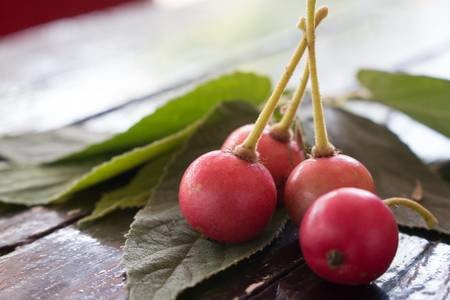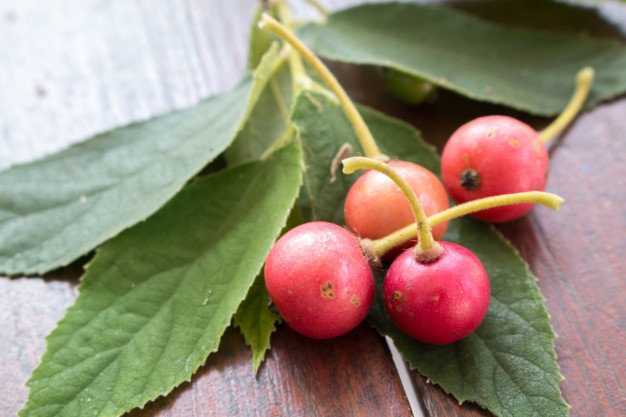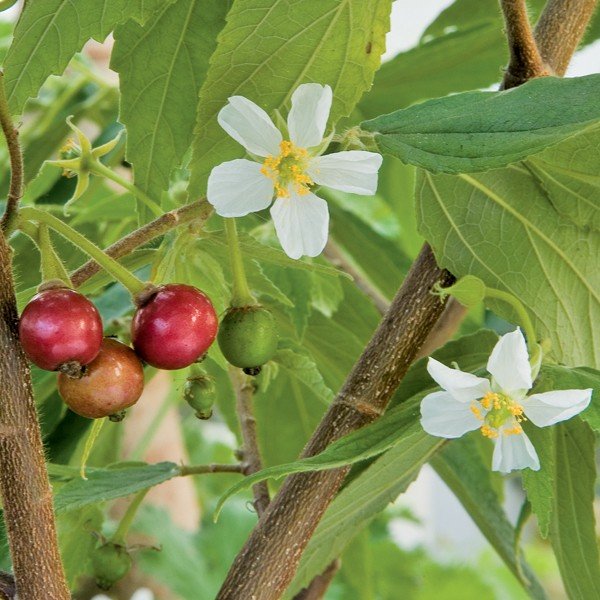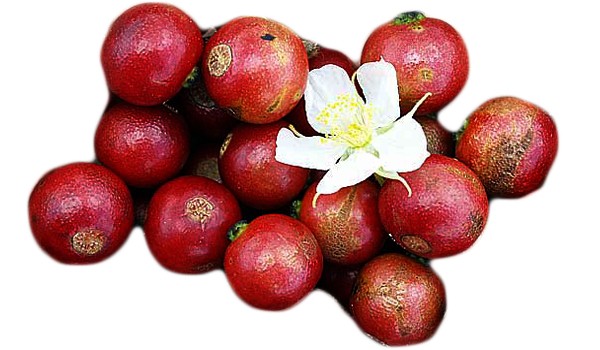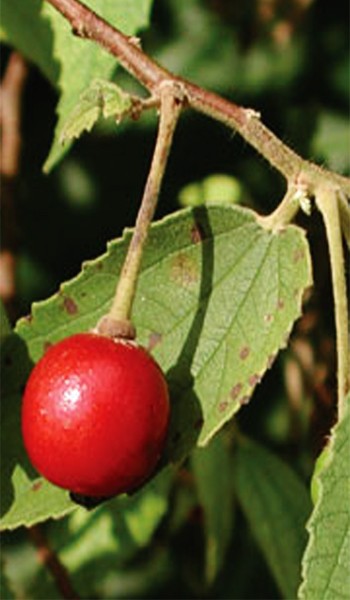- Overview
Common Name: Strawberry Tree Botanical Name: Muntingia calabura Family: Elaeocarpaceae
Origin: Southern Mexico
Avg. Height x Width: 25 F x 25 F
Strawberry Tree/Jamaican Cherry Tree/Capulin Cherry in a 3 Gallon Container. The fruit of the Strawberry Tree are born on the outstretched branches of the tree. Each fruit is about the size of a blueberry and contains an tiny yellowish seeds too small to be noticed when eating. The flavor is often compared to cotton candy strawberry. The trees are highly ornamental and fast growing providing a good source of shade and a fruit that is a favorite among children. Tree fruits year round so it makes a great addition to any garden. Can also be kept under 6 feet tall and grown in a container. Children love these sweet fruit and they make great treats.
Description
Origin and Distribution
Climate
Soil
Propagation
Culture
Season
Pests and Diseases
Food Uses
Food Value
Other Uses
Medicinal Uses
This is a minor but well-known and wholesome fruit, borne by a multipurpose tree and therefore merits inclusion. The Jamaica cherry, Muntingia calabura L., is a member of the family Elaeocarpaceae. It has acquired a wide assortment of vernacular names, among them capuli or capulin which are better limited to Prunus salicifolia (q.v.). In Florida, it has been nicknamed strawberry tree because its blooms resemble strawberry blossoms, but strawberry tree is a well-established name for the European ornamental and fruit tree, Arbutus unedo L., often cultivated in the western and southern United States, and should not be transferred to the Jamaica cherry. In Mexico, local names for the latter are capolin, palman, bersilana, jonote and puan; in Guatemala and Costa Rica, Muntingia calabura is called capulin blanco; in El Salvador, capulin de comer; in Panama, pasito or majagüillo; in Colombia, chitató, majagüito, chirriador, acuruco, tapabotija and nigua; in Venezuela, majagua, majaguillo, mahaujo, guácimo hembra, cedrillo, niguo, niguito; in Ecuador, nigüito; in Peru, bolina, iumanasa, yumanaza, guinda yunanasa, or mullacahuayo; in Brazil, calabura or pau de seda; in Argentina, cedrillo majagua; in Cuba, capulina, chapuli; in Haiti, bois d' orme; bois de soie marron; in the Dominican Republic, memiso or memizo; in Guadeloupe, bois ramier or bois de soie; in the Philippines, datiles, ratiles, latires, cereza or seresa; in Thailand, takop farang or ta kob farang; in Cambodia, kakhop; in Vietnam, cay trung ca; in Malaya, buah cheri; kerukup siam or Japanese cherry; in India, Chinese cherry or Japanese cherry; in Ceylon, jam fruit.
Description
This is a very fast-growing tree of slender proportions, reaching 25 to 40 ft (7.5-12 in) in height, with spreading, nearly horizontal branches. The leaves are evergreen, alternate, lanceolate or oblong, long-pointed at the apex, oblique at the base; 2 to 5 in (5-12.5 cm) long, dark-green and minutely hairy on the upper surface, gray- or brown-hairy on the underside; and irregularly toothed. The flowers, borne singly or in 2's or 3's in the leaf axils, are 1/2 to 3/4 in (1.25-2 cm) wide with 5 green sepals and 5 white petals and many prominent yellow stamens. They last only one day, the petals falling in the afternoon. The abundant fruits are round, 3/8 to 1/2 in (1-1.25 cm) wide, with red or sometimes yellow, smooth, thin, tender skin and light-brown, soft, juicy pulp, with very sweet, musky, somewhat fig-like flavor, filled with exceedingly minute, yellowish seeds, too fine to be noticed in eating.
Origin and Distribution
The Jamaica cherry is indigenous to southern Mexico, Central America, tropical South America, the Greater Antilles, St. Vincent and Trinidad. The type specimen was collected in Jamaica. It is widely cultivated in warm areas of the New World and in India, southeast Asia, Malaya, Indonesia, and the Philippines, in many places so thoroughly naturalized that it is thought by the local people to be native. Macmillan says that it was first planted in Ceylon about 1912. Several trees were introduced into Hawaii by the United States Department of Agriculture in 1922. Dr. David Fairchild collected seeds of a yellow-fruited form in the Peradeniya. Botanic Gardens, Ceylon, in 1926 (S.P.I. #67936). The tree has been grown in southern Florida for its fruits and as quick shade for nursery plants. It is seldom planted at present. Volunteers from bird-distributed seeds spring up in disturbed hammocks and pinelands. The author supplied seeds requested by the Kenya Agriculture Research Institute, Kihuyu, in 1982. The Jamaica cherry is said to grow better than any other tree in the polluted air of Metropolitan Manila. It runs wild on denuded mountainsides and on cliffs and is being evaluated for reforestation in the Philippines where other trees have failed to grow and also for wildlife sanctuaries since birds and bats are partial to the fruits. The fruits are sold in Mexican markets. In Brazil, they are considered too small to be of commercial value but it is recommended that the tree be planted on river banks so that the abundance of flowers and fruits falling into the water will serve as bait, attracting fish for the benefit of fishermen. In Malaya, the tree is considered a nuisance in the home garden because fruit-bats consume the fruits and then spend the day under the eaves of houses and disfigure the porch and terrace with their pink, seedy droppings.
Climate
The Jamaica cherry is tropical to near-tropical. The mid-19th Century botanist, Richard Spruce saw it in Ecuador "in the plains on both sides of the Cordillera" growing "abundantly by the Rio San Antonio, up to 2,500 ft" (760 m). It is found up to 4,000 ft (1,300 m) in Colombia. When well-established, it is not harmed by occasional low winter temperatures in southern Florida.
Soil
The tree has the reputation of thriving with no care in poor soils and it does well in both acid and alkaline locations, and even on old tin tailings in Malaya. It is drought-resistant but not salt-tolerant.
Propagation
Brazilian planters sow directly into the field fresh seeds mixed with the sweet juice of the fruit. To prepare seeds for future planting, water is added repeatedly to the squeezed-out seeds and juice and, as the seeds sink to the bottom of the container, the water is poured off several times until the seeds are clean enough for drying in the shade.
Culture
The planting hole is prepared with a mixture of organic fertilizer and soil and with a fungicidal solution to prevent the young seedlings from damping-off. To assure good distribution of the seeds, they are mixed with water and sown with a sprinkling can. When well fertilized and watered, the seedlings will begin fruiting in 18 months and will be 13 ft (4 m) high in 2 years.
Season
Wherever it grows, fruits are borne nearly all year, though flowering and fruiting are interrupted in Florida and Sao Paulo, Brazil, during the 4 coolest months. Ripe fruits can easily be shaken from the branches and caught on cloth or plastic sheets.
Pests and Diseases
In Florida, in recent years, the fruits are infested with the larvae of the Caribbean fruit fly and are accordingly rarely fit to eat. The foliage is subject to leaf spot caused by Phyllosticta sp. and Pseudocercospora muntingiae (formerly Cercospora muntingiae), and the tree is subject to crown gall caused by Agrobacterium tumefaciens.
Food Uses
The Jamaica cherry is widely eaten by children out-of-hand, though it is somewhat sticky to handle. It is often cooked in tarts and made into jam. The leaf infusion is drunk as a tea-like beverage.
Food Value Per 100 g of Edible Portion *
Moisture 77.8 g
Protein 0.324 g
Fat 1.56 g
Fiber 4.6 g
Ash 1.14 g
Calcium 124.6 mg
Phosphorus 84.0 mg
Iron 1.18 mg
Carotene 0.019 mg
Thiamine 0.065 mg
Riboflavin 0.037 mg
Niacin 0.554 mg
Ascorbic Acid 80.5 mg
*Analyses made in El Salvador.
Other Uses
Wood: The sapwood is yellowish, the heartwood red-dish-brown, firm, compact, fine-grained, moderately strong, light in weight, durable indoors, easily worked, and useful for interior sheathing, small boxes, casks, and general carpentry. It is valued mostly as fuel, for it ignites quickly, burns with intense heat and gives off very little smoke. Jamaicans seek out trees blown down by storms, let them dry for a while and then cut them up, preferring this to any other wood for cooking. It is being evaluated in Brazil as a source of paper pulp.
Bark: The bark is commonly used for lashing together the supports of rural houses. It yields a very strong, soft fiber for twine and large ropes.
Medicinal Uses
The flowers are said to possess antiseptic properties. An infusion of the flowers is valued as an antispasmodic. It is taken to relieve headache and the first symptoms of a cold. - Features
weight: 9.99 lbs : - ReviewsThere is no reviews yet...Be the first!
Be the first to write a review of this product!
